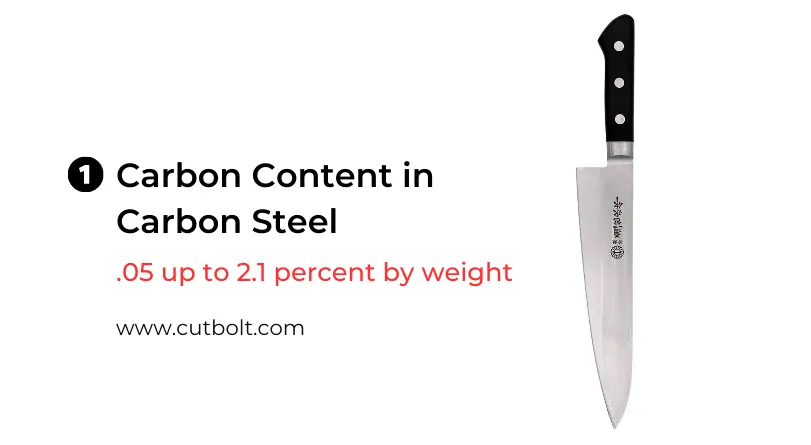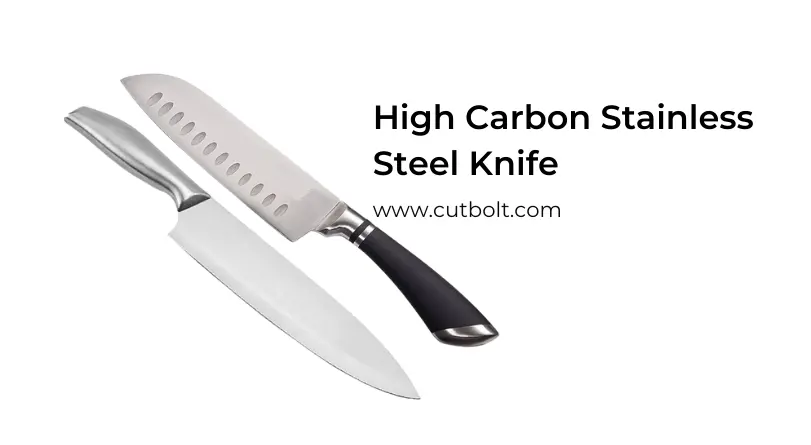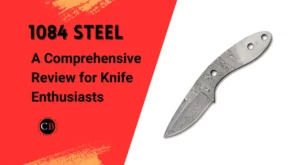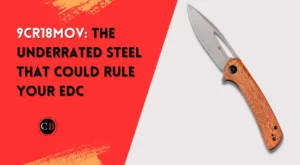Carbon vs stainless steel knife – the fight goes on!
In the tantalizing world of cutlery, the battle between carbon steel and stainless steel knives rages on. With their unique attributes and distinctive benefits, these two knife types have carved their place in the hearts of cooks around the globe.
Join us as we dive deep into the realm of blades, uncovering the sizzling showdown between carbon steel vs stainless steel knife, all to find your ultimate kitchen companion.
Get ready to slice, dice, and discover the key that unlocks culinary excellence!
Find the best knives for cutting raw meat here.
- What is stainless steel?
- What is carbon steel?
- Stainless Steel vs Carbon Steel Knife: Characteristics
- Carbon steel vs Stainless steel knife: Maintenance
- Carbon steel knife vs Stainless steel knife: Resistance
- Difference in price: Carbon steel knives and Stainless steel knives
- Is carbon steel or stainless steel better for me?
- High carbon stainless steel knife pros and cons
- High carbon stainless steel vs Stainless steel
- Keep in mind: Moisture is the enemy of steel
- FAQs: Carbon vs Stainless Steel Knife
- Carbon steel vs Stainless steel knife: Summary

What is stainless steel?
Stainless steel is a type of steel alloy that contains a minimum of 10.5% chromium content by mass. It is known for its excellent corrosion resistance, making it highly suitable for various applications where resistance to rust and staining is essential.
The addition of chromium forms a thin, invisible layer of chromium oxide on the surface of the steel, which prevents the formation of iron oxide (rust) and protects it from corrosion.
Apart from chromium, stainless steel may also contain other elements such as nickel, molybdenum, titanium, and manganese, among others. Each of these elements imparts specific properties to the stainless steel, such as increased strength, improved resistance to certain types of corrosion, or enhanced machinability.
There are different grades of stainless steel available, each with unique properties suitable for specific applications.
Some common types of stainless steel include:
- Austenitic stainless steel: These are the most common types and are non-magnetic with excellent corrosion resistance. They are often used in applications where hygiene and sanitation are critical, such as in the food and beverage industry.
- Ferritic stainless steel: These are also non-magnetic and possess good corrosion resistance. They are frequently used in automotive applications and indoor architectural features.
- Martensitic stainless steel: Known for their hardness and strength, these steels are commonly used in making knives, cutting tools, and other items requiring sharp edges.
- Duplex stainless steel: These have a mixed microstructure of austenite and ferrite, providing a balance of strength and corrosion resistance. They are used in applications like chemical processing and marine environments.
- Precipitation-hardening stainless steel: These steels can be heat-treated to improve their strength and hardness, making them suitable for aerospace and high-stress applications.
Stainless steel is used in a wide range of industries, including construction, transportation, medical equipment, kitchen utensils, appliances, and many others where its durability and corrosion resistance are highly valued.

What is carbon steel?
Carbon steel is a type of steel that primarily consists of iron and carbon, with trace amounts of other elements. It is one of the most common and widely used types of steel due to its versatility, affordability, and various mechanical properties. The carbon content in carbon steel typically ranges from 0.05% to 2.0% by weight.
The amount of carbon present in the steel significantly influences its properties, such as hardness, strength, and ductility.
There are three main types of carbon steel based on their carbon content:
- Low Carbon Steel: Also known as mild steel, low carbon steel contains a relatively low amount of carbon (usually up to 0.30% by weight). It is relatively soft and easy to form, making it suitable for applications such as sheet metal, structural components, and car bodies.
- Medium Carbon Steel: This type of carbon steel contains a higher carbon content (between 0.30% and 0.60% by weight). It offers a balance between strength and ductility and is commonly used in the manufacturing of gears, axles, and machinery parts.
- High Carbon Steel: High carbon steel contains a higher carbon content (up to 2.0% by weight). It is the hardest and strongest among the three types but is less ductile and more brittle. High-carbon steel is commonly used for cutting tools, knives, and springs.
The properties of carbon steel can be further modified by adding alloying elements such as manganese, silicon, and sometimes small amounts of other elements like chromium, nickel, and vanadium.
These additions can enhance specific properties like hardness, wear resistance, and toughness, making the steel suitable for specific applications.
Carbon steel is widely used in various industries, including construction, automotive, machinery, and infrastructure.
However, its susceptibility to corrosion can be a limitation in certain environments. To address this, stainless steel (which contains chromium for corrosion resistance) is often used in applications where protection against rust and corrosion is vital.

Stainless Steel vs Carbon Steel Knife: Characteristics
Characteristics of Stainless Steel Knife
Stainless steel, a widely used metal alloy like carbon steel, possesses several key characteristics that set it apart.
- The primary advantage of stainless steel lies in its exceptional corrosion resistance, making it highly suitable for various applications.
- Comprising chromium and iron, stainless steel finds its use in the production of a diverse array of items, including food and pharmaceutical containers, surgical instruments, wires, sinks, patio furniture, water pipes, and cable trays.
- The chromium content in stainless steel varies between 10% and 35%, depending on the specific grade being produced. This crucial element forms chromium oxide, which creates a protective layer safeguarding the steel against rust and corrosion.
To enhance specific properties, stainless steel can be alloyed with metals like nickel, titanium, and others. This versatility results in a vast selection of hundreds of different stainless steel alloys to choose from.
Characteristics of Carbon Steel Knife
Carbon steel, an alloy of iron and carbon, is among the most extensively utilized commercial metals worldwide. It offers superior strength, making it highly valuable for applications that require robust materials.
The carbon content is a key factor in classifying and assessing carbon steels, which are divided into the following groups based on their percentage of total carbon:
- Low-carbon steel: Contains up to 0.25 percent carbon (e.g., AISI 304).
- Medium carbon steel: Contains 0.25 percent to 0.60 percent carbon (e.g., AISI 409).
- High carbon steel: Contains 0.60 percent to 1.25 percent carbon (e.g., AISI 440C).
These categorizations assist in analyzing the physical properties of the steel and aid steel manufacturers in determining the most suitable applications for each type.
In the meantime, if you wish to learn about all the knife metals you can read a detailed guide on different kitchen knives here.

Resources you can use:
- Nakiri vs Santoku knives
- Best Knives for Cutting Vegetables
- Best Knives for Cutting Raw Meat
- G10 vs Micarta for knife handles
Carbon steel vs Stainless steel knife: Maintenance
1. Maintenance of stainless steel knives
It is very likely that the knives you currently have are made of stainless steel, as they are the most common.
These types of knives need almost no maintenance or care. You will not have to grease the blades of these knives and they are not sensitive to the acid that some foods such as lemons, tomatoes, etc. contain.
We can say that stainless steel knives practically do not spoil and are for life.
2. Maintenance of carbon steel knives
The choice of a knife can be compared to the choice of frying pans, which, whether they are cast iron or non-stick, will fulfill their function. One is not better than the other, but depending on your preferences and lifestyle you will choose one model or another.
Carbon steel knives contain carbon and are more reactive than stainless steel. For this reason, this type of knives tends to change over the years. In addition, the blades of these knives initially need to be treated to adapt and prepare them for the rest of their useful life. This adaptation can be compared to cast iron frying pans that need to be seasoned at the beginning of their life.
With carbon steel knives you will have to avoid cutting acidic products, keep the blade dry when not in use and grease it often.
When we say don’t cut acids with them, we don’t mean that you can’t cut lemons. It is simply that if you do, you must clean and dry the knife completely.
But don’t be afraid that this maintenance only needs to be done when they are new and the patina is still forming.
With use, a protective layer is formed that acts as a non-stick layer when cutting the product. You will see this for yourself as the knife changes its appearance.
As you can see, the maintenance of these knives is only at the beginning of their useful life and is very simple. When they have been used several times and have created that protective layer, they do not need any more maintenance.

Carbon steel knife vs Stainless steel knife: Resistance
In the comparison between carbon steel and stainless steel, the latter demonstrates superior performance and tensile strength.
However, to obtain precise comparisons, it is essential to consider the specific type of carbon or stainless steel being used, whether it falls under the category of high, medium, or low carbon steel, or belongs to the various grades of stainless steel.
Stainless steel Resistance
- Austenitic stainless steel possesses a tensile strength ranging from 72,000 to 115,000 pounds per square inch.
- Martensitic stainless steel exhibits a higher tensile strength, varying between 72,000 and 160,000 pounds per square inch.
- Ferritic stainless steel’s tensile strength falls within the range of 65,000 to 87,000 pounds per square inch.
Carbon steel Resistance
- Low carbon steel exhibits a tensile strength ranging from 60,000 to 80,000 XNUMX XNUMX pounds per square inch.
- Medium carbon steel, on the other hand, showcases a higher tensile strength, varying between 100,000 and 120,000 pounds per square inch.
- Alloy steel, with its superior strength, boasts a tensile strength greater than 150,000 pounds per square inch.
Difference in price: Carbon steel knives and Stainless steel knives
The price difference between carbon steel and stainless steel is a crucial aspect to take into account.
Generally, stainless steels tend to be more costly than carbon steel, although the prices can vary based on the specific grade.
This price disparity is primarily attributed to the inclusion of alloying elements such as chromium, nickel, manganese, and others in stainless steel. These additional components contribute to the higher overall cost compared to carbon steel, which mainly consists of inexpensive iron and carbon components.
If you are on a tight budget, considering the price comparison between carbon steel and stainless steel, opting for carbon steel might be a more economical choice.
Is carbon steel or stainless steel better for me?
When choosing between the different types of knives, we advise you to ask yourself if you are a meticulous person.
Think about whether it can cause you any problems to have to clean and dry your knives continuously.
If you take a look around your kitchen and see that your cutting board is dirty or you have water around your sink, you may conclude that you are not a very tidy person.
In this case, carbon steel knives may not be right for you. The cleanliness and organization of your kitchen can give you the solution when choosing between a carbon steel or stainless steel knife.
High carbon stainless steel knife pros and cons
Pros of high carbon stainless steel knife:
- Sharper edge – High carbon steel can be sharpened to a very fine edge and hold that sharp edge well. This makes the knife cut cleanly and precisely.
- Harder steel – The additional carbon gives the steel more hardness, improving edge retention and reducing wear over time.
- Corrosion resistant – The stainless steel provides good corrosion resistance compared to plain carbon steel knives.
Cons of high carbon stainless steel knife:
- Brittle – The harder steel is more brittle and prone to chipping if abused. Must be used with care.
- Difficult to sharpen – The harder steel that improves edge retention also makes the knife more difficult for the average user to sharpen. May require professional sharpening.
- Staining – High carbon stainless can still stain or corrode if not properly cared for. Requires more maintenance than low-carbon stainless knives.
- Expensive – The combination of high-carbon steel and stainless steel makes these knives cost more than plain carbon or stainless knives.
- Heavy – The denser high carbon stainless steel adds weight compared to other common kitchen knife materials.
High carbon stainless steel vs Stainless steel
| Property | High Carbon Stainless Steel | Stainless Steel |
|---|---|---|
| Hardness | Very hard due to high carbon content | Less hard than high carbon stainless |
| Edge Retention | Excellent due to hardness | Good but less than high carbon |
| Sharpening | Difficult due to hardness | Easier to sharpen than high carbon |
| Corrosion Resistance | Good but lower than regular stainless | Excellent corrosion resistance |
| Lighter than high-carbon stainless | More brittle due to hardness | Less brittle |
| Weight | Heavier due to higher density | Less expensive than high-carbon stainless |
| Cost | More expensive due to materials | Less expensive than high carbon stainless |
Keep in mind: Moisture is the enemy of steel
As you can see, moisture is not a good friend of carbon steel knives. This does not mean that stainless steel knives cannot also be damaged by humidity, as they can also rust or discolor. Although it is true that stainless steel knives are much more resistant to water.
FAQs: Carbon vs Stainless Steel Knife
Q: What is the primary difference between carbon steel and stainless steel knives?
Carbon steel knives have higher carbon content, making them harder but more prone to rust. Stainless steel knives have lower carbon content, offering better rust resistance but slightly less hardness.
Which type of knife holds a sharper edge?
Generally, carbon steel knives can be sharpened to a finer edge than stainless steel knives due to their higher hardness.
Do carbon steel knives require more maintenance than stainless steel knives?
Yes, carbon steel knives require more maintenance as they are susceptible to rust. Regular oiling and drying are necessary to prevent corrosion.
Are stainless steel knives completely rust-resistant?
Although stainless steel knives have excellent rust resistance, they are not entirely rust-proof. Proper care and cleaning are still important to maintain their longevity.
Which type of knife is more suitable for cutting meat and vegetables?
Both carbon steel and stainless steel knives are suitable for cutting meat and vegetables. The choice depends on personal preference and maintenance commitment.
Does the type of steel affect the knife’s weight?
The type of steel used does not significantly affect a knife’s weight. Factors like the blade thickness, handle material, and design have a greater impact on the overall weight.
Can carbon steel knives react with acidic or alkaline foods?
Yes, carbon steel knives can react with acidic or alkaline foods, potentially affecting the taste and appearance of the food. Stainless steel knives are more resistant to chemical reactions.
Which type of knife requires more frequent sharpening?
Carbon steel knives typically require more frequent sharpening due to their higher hardness and ability to hold a finer edge.
Are carbon steel knives more likely to develop patina over time?
Yes, carbon steel knives tend to develop a natural patina over time, which is a protective layer that can appear as a dark, non-stain surface on the blade.
Are stainless steel knives more expensive than carbon steel knives?
The cost of knives depends on various factors, including the brand, craftsmanship, and specific type of steel used. Generally, high-quality stainless steel knives can be more expensive than carbon steel knives.
Carbon steel vs Stainless steel knife: Summary
After this detailed analysis, as a conclusion, we will say that carbon steel knives are ideal for those people who live in drier environments (where there is little humidity in the environment). It will be easy to maintain a carbon steel knife in dry weather. If you finally choose to buy a carbon steel knife, the only thing you will have to take care of is keeping the knife blade clean and dry, after each use.
On the other hand, if you live in a fairly humid climate or where humidity is constant, it is best to opt for stainless steel knives.
When deciding between various types of knives, it’s not a matter of determining which one is inherently superior. The crucial factor is to identify the knife that aligns best with your specific kitchen needs and style of work. Metallurgy companies attest that both stainless steel and carbon steel are capable of producing excellent and long-lasting knives today.
If you still have doubts about what type of knife to buy according to its blade, we invite you to read our article on types of knife steel. You are sure to find the knife that best suits your needs!



